March 9, 2018
Air Date: March 9, 2018
FULL SHOW
SEGMENTS
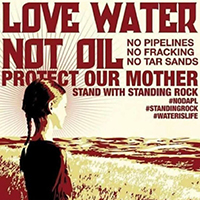
'Green' Russian Trolls
View the page for this story
Russian Internet trolls from the same outfit that Special Counsel Robert Mueller blames for meddling in the 2016 U.S. elections also targeted more than 9,000 social media posts at fossil fuel flash points, such as the Dakota Access Pipeline. This according to a report from the Republican majority of the House Science Committee. Energy reporter Tim Puko of The Wall Street Journal tells host Steve Curwood that the Russian posts were meant to sow discord in the US but the Republican report declares those Russian efforts had seemingly minimal impact in social media. Puko also says the report should be viewed in the context of Republican political benefit. (08:40)
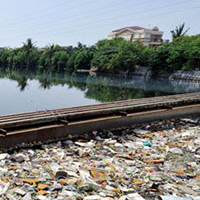
Beyond the Headlines
/ Peter DykstraView the page for this story
This week Peter Dykstra and host Steve Curwood look Beyond the Headlines at the proposed cleanup of the Citarum, possibly the world’s dirtiest river, and discuss the recent arrest of a high ranking official in connection with the 2016 murder of Honduran environmental activist Berta Cáceres. And they remember a 1925 Tennessee law that prohibited schools from teaching evolution and created a courtroom circus, the “Scopes Monkey Trial,’ later recounted in a book and movies with the title, Inherit the Wind. (04:00)
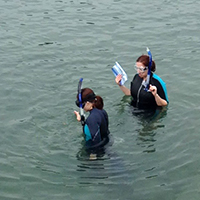
Gulf Orphans
/ Noble IngramView the page for this story
When the Gulf Stream's ocean currents circulate up the Atlantic coast of North America, they aren't just pulling warm water north, they’re carrying marine life as well. Living on Earth's Noble Ingram reports from a beach in Jamestown, RI where local scientists seek to rescue juvenile tropical fish swept north from the Caribbean. (09:40)
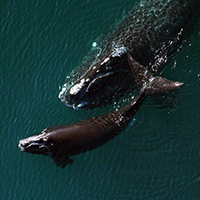
No Northern Right Whale Calves So Far This Year
/ Jenni DoeringView the page for this story
It’s long been illegal to hunt Northern Right whales, but this endangered species’ population is still declining. After an unprecedented number of deaths among the North Atlantic Right whales last year, no new births have been recorded so far this year either. Regina Asmutis-Silvia of the North American branch of Whale and Dolphin Conservation discussed this ecologically critical species and prospects for its future with Living on Earth’s Jenni Doering. (08:10)
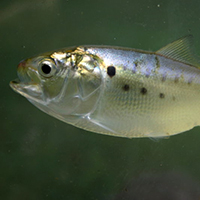
Ocean Health: Some Hope and Much Peril
View the page for this story
Host Steve Curwood discusses the state of the world’s oceans with MacArthur ‘genius’ and ecologist Carl Safina. Climate change and ocean acidification are cause for alarm but Safina says better fishery management has resulted in a growth of some fish stocks. (09:05)
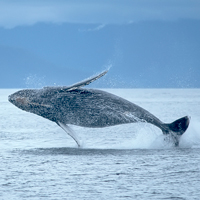
Whales at Home in the Caribbean
/ Bobby BascombView the page for this story
In the spring, humpback whales begin their annual migration north to the cold, food-rich waters of the North Atlantic. But they spend the winter enjoying the warm waters of the Dominican Republic. Living on Earth’s Bobby Bascomb reports. (04:20)
Show Credits and Funders
Show Transcript
HOST: Steve Curwood
GUESTS: Tim Puko, Regina Asmutis-Silvia, Carl Safina
REPORTERS: Noble Ingram, Peter Dykstra, Bobby Bascomb, Jenni Doering
HOST: Steve Curwood
GUESTS: Tim Puko, Regina Asmutis-Silvia, Carl Safina
REPORTERS: Noble Ingram, Peter Dykstra, Bobby Bascomb, Jenni Doering
[NEWSBREAK MUSIC: Boards Of Canada “Zoetrope” from “In A Beautiful Place Out In The Country” (Warp Records 2000)]
'Green' Russian Trolls
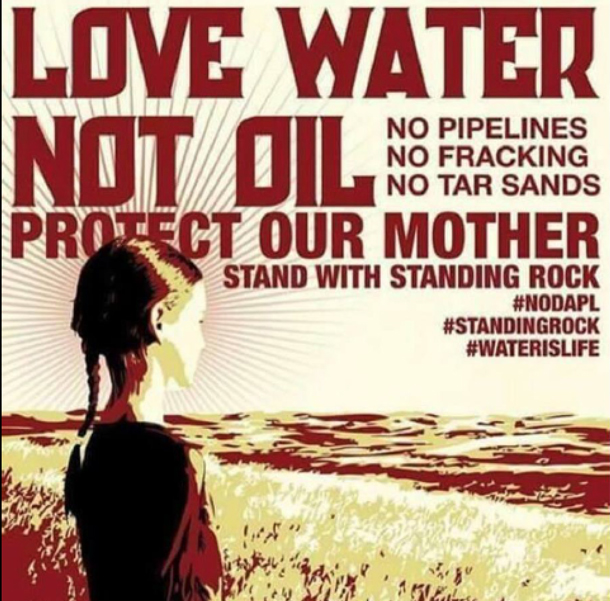
This image was posted on Instagram on February 14, 2017 by an Internet Research Agency-linked account called “native_americans_united,” and generated 718 likes and 14 comments. (Photo: House of Representatives Committee on Science, Space and Technology)
[THEME]
CURWOOD: From PRI, and the Jennifer and Ted Stanley Studios at the University of Massachusetts, Boston, this is Living on Earth. I’m Steve Curwood. As the investigation into Russian interference in the 2016 U.S. elections grinds on, a House committee also accuses the IRA, that’s Russia’s Internet Research Agency, of trying to pit environmental activists against fossil fuel advocates.
The House Science Committee, chaired by Republican Lamar Smith of Texas, prepared the report. It analyzed how that Russian troll farm – also targeted by Special Counsel Robert Mueller - hyped controversies about pipelines, hydraulic fracturing, and climate change on Facebook, Twitter and Instagram. Tim Puko covers energy policy for The Wall Street Journal and wrote about the report – welcome to Living on Earth!
PUKO: Hi, thank you very much.
CURWOOD: So, what evidence does this report offer to support its finding that Russia has been trying to influence US domestic energy markets by exploiting social media?
PUKO: They reached out to a lot of the biggest social media companies and those companies turned over a lot of posts from some of the same Russian agents who were caught up in the Mueller investigation recently. These were meme-like posts that were created by some of those agents, typically to take the side of environmentalists in different controversies surrounding oil and gas development, new pipelines. Sometimes they took the other side and made fun of the Not In My Backyard types who didn't want renewable energy or clean energy projects in their area, but mostly it was pretty clear that these posts were designed to enflame fears from people who have environmental concerns or health concerns about, typically, fossil fuel development.
CURWOOD: So, Tim, we've looked at some of these posts. They are rather provocative. There's one that has a woman, maybe she's a girl, she's looking at the planes, it says “Love water not oil,” “Protect our mother, stand with Standing Rock,” and hashtags for some of the Standing Rock concerns, and there's a flip side that shows a shiny row of pipe connections and then it a shows dump, really. That's what it looks like after protesters came through trash everywhere, posted by something called maybe America First and Stand for Freedom. These certainly looked like they were designed to enflame conflict.
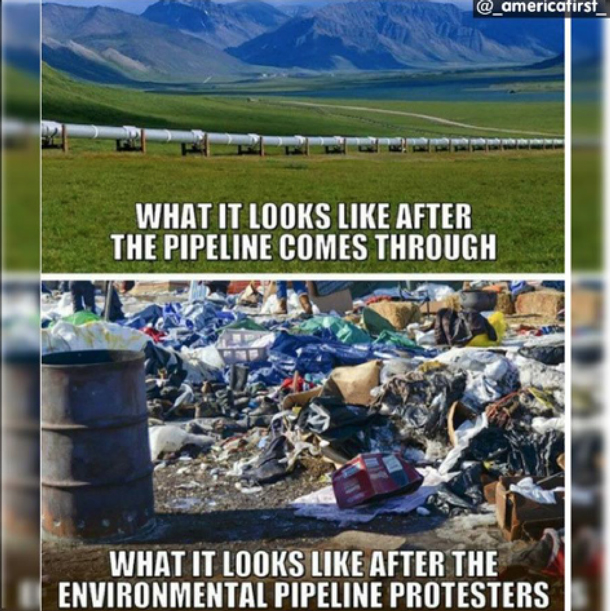
While most posts appealed to green social media users, others had the opposite tone, such as this Instagram image posted from the accounts named “_americafirst_” and “stand_for_freedom”. Those posts received 3,076 and 1,774 likes, respectively. (Photo: House of Representatives Committee on Science, Space and Technology)
PUKO: Yeah, it's pretty clear I think, if you think about all the other things that these Russian agents have been accused of doing. They are trolls in every sense of the word, at least from what we know of the allegations. One thing that I think is important to note about what this committee turned over is that a lot of these posts don't have a lot of engagement. Their shares are relatively low. Their replies are relatively low. I think at best a couple of them maybe got a thousand, or a few thousand replies or types of engagement in some way, but a lot of them had just a handful. I think it's a pretty long bridge that you have to build to look at these posts and, say, “Well they are really influential in stirring up both sides here or one side or another”. They didn't really get a whole lot of engagement in the end, most of them.
CURWOOD: We know about Russian attempts to sway the US election, but why would Russia want to influence American opinions on energy policy?
PUKO: I think this is actually, maybe, the most interesting element in this case. We've heard about the IRA and all the different ways they are allegedly tried to sow discord through the election through homing in our racial issues, hot button issues like that. This is the first time that we've heard of them trying to stir things up in America in a way that would directly benefit Russia potentially.

The Instagram accounts “americanfury”, “southern.rebel.pride”, and “wall_up” posted this meme in July 2017 and altogether received about 10,000 likes. (Photo: House of Representatives Committee on Science, Space and Technology)
You think about how the world of energy has changed in the past 10 years with the oil boom in the US. Russian production is up a lot too. They are now the world's leading oil producer and the most recent data suggests that that'll change in a few years, that the US is about to start competing with Russia for that title as the world's top oil producer. They're both huge natural gas producers too and they're both especially increasingly in the US going to be exporting a lot of that gas. So, these two countries in a very real way on a global stage are competing for markets in energy and if there's something that Russia can do to undermine development of oil and gas in the US, that stands to benefit Russia because that's less supply that the US can put on the market and more room for Russia to sell more of its supply.
CURWOOD: Now, if I understand the report correctly, Tim, it looked at these Russian troll farms and said that about four percent of their activity was linked to this energy disinformation, whatever you want to call it, campaign, but some eight percent was linked to the questions we know around the election. So, the Russians seem to be taking this energy business pretty seriously, I gather.
PUKO: I think that was the other startling point about it, is how much energy - sorry for the pun – but how much energy they put behind this, how much of their resources they devoted to this particular topic, and it goes back to this idea of Russia and the US competing on the global stage. This is something that can really benefit them; the outcome of it were successful would be to undermine production in the US, undermine the country's ability to get newfound supplies of oil and gas from the center of the country to coastal ports where it's exported.

This meme, as with most that the report highlighted, received far less engagement on Facebook than on Instagram – 21 versus 784 likes, respectively. (Photo: House of Representatives Committee on Science, Space and Technology)
CURWOOD: Now, Representative Lamar Smith, chairman of the House Science Committee, is well known for his climate change denial and of course has been pretty friendly to oil and gas during his 30 years in Congress, being from Texas. To what extent does that affect the credibility of this report, do you think?
PUKO: Well, I don't want to personally make any judgments on the credibility, but I think one thing to note about the committee and the staff that investigated it is that it wasn't a bipartisan effort. This was from Republican leadership on the committee - of course, they have the majority on the committee - and while a lot of studies or reports and investigations that come out of Congressional committees like this are done on a bipartisan basis, this one was not. This was something that we've heard from the Democratic staff that they did not even know about, and so it is, you know, politically pretty obvious to say, well, right now if you're a Republican in DC and you can point to what's going on in this sort of soft conflict between Russia and the United States, one that has embroiled the President Trump's administration so much and say, “Well hey, it's not just the President, there aren't just implications here Republican versus Democrat, here is another issue where Russian trolls allegedly came after a part of US society that is really not all that partisan.”

“Born Liberal” posted this meme on Facebook, where it received just 9 likes, as opposed to the 1,794 it received when the account “bornliberal” posted it on Instagram the same day. (Photo: House of Representatives Committee on Science, Space and Technology)
Of course, typically I think Democrats are going to be friendlier to environmentalists, but we all benefit from having a robust energy industry, especially if we have one that is producing more and selling more and creating more economic activity there than one of our top geo-political rivals. So, for the committee to come out and say, “Hey, it's not just the thing that is affecting President Trump, it's affecting the American economy”, there are reasons to think that that would be politically beneficial to a group of Republicans in Washington right now.
CURWOOD: Tim, the report also makes a claim that quote, "the Kremlin is manipulating environmental groups in an attempt to carry out their agenda,” and I guess last June, Chairman Smith sent a letter to the Treasury Secretary Steven Mnuchin claiming that shell companies and private foundations were passing Russian money to big environmental groups here in the United States. Those are pretty damning claims. How fair are those claims, and how are the environmental nonprofits responding to those kind of charges?
PUKO: You hear those claims a lot in Washington these days. Personally, I'd like to see more evidence on that first. I don't know how much veracity there is to those claims. It's important to note that there are legitimate concerns that these groups have, even if there are some Russian trolls out in the internet trying to incite fears. Well, you know, pipelines can pose a lot of risks to the environment. There are a lot of studies out there that suggest that living near a well site in particular can be dangerous to health in one way or another, and they are very legitimate concerns.
CURWOOD: Tim Puko is an energy policy reporter for The Wall Street Journal. Tim, thanks so much for taking the time with us today.
PUKO: Thanks so much for having me.
Related links:
- The Wall Street Journal: “Russian Meddling on Social Media Targeted U.S. Energy Industry, Report Says”
- Read the report, “Russian Attempts to Influence U.S. Domestic Energy Markets by Exploiting Social Media”
- Members on the House Committee for Science, Space, and Technology
[MUSIC: https://www.youtube.com/watch?v=cbJZeNlrYKg
Joshua Bell - Tchaikovsky - Violin Concerto in D major, Op 35, National Youth Orchestra of the United States of America Valery Gergiev, conductor live recording. London, Proms 2013]
Beyond the Headlines
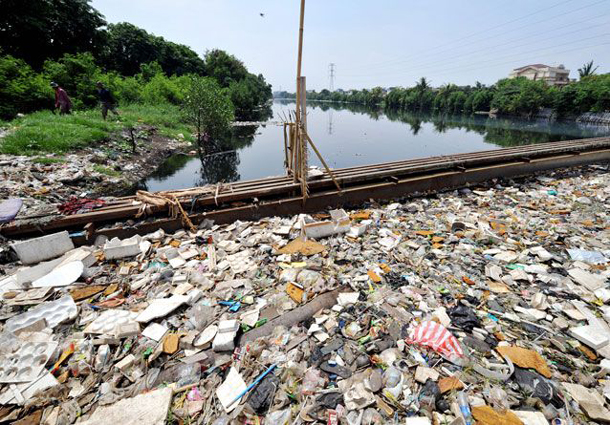
The Indonesian government is pledging to make water in the Citarum River drinkable by 2025. (Photo: Chief, Wikimedia Commons CC BY-SA 4.0)
CURWOOD: Off to Atlanta, Georgia, now for our regular check in on the world beyond the headlines with Peter Dykstra. Peter’s an editor with Environmental Health News, that’s ehn.org and DailyClimate dot org – hi there, Peter. What did you find this week?
DYKSTRA: Hi Steve. You know, there are a lot of rivers in a lot of countries, like India and China, that may have a good claim to be the world’s dirtiest river.
CURWOOD: Oh, yeah?
DYKSTRA: That’s absolutely true. But the Citarum River, which runs through Jakarta, the capital city of Indonesia, has a fantastic claim.
CURWOOD: So what’s going on there?
DYKSTRA: Well, they have 2,000 textile mills upstream from Jakarta. Ten million people in Jakarta, 80 percent of them rely on the river for everything from household water to drinking water. There are sewage problems, there are trash problems, and the Indonesian government is launching an effort to clean the river up.
CURWOOD: Yeah, how are they gonna fix all that?
DYKSTRA: Well, they say by dredging the bottom of the river, which is heavily polluted, there are lead pollution problems there; they’re going to tighten the laws about dumping into the river; and, finally, enforce the laws. They’ve been largely unenforced. And they say they can make the river drinkable by the year 2025.
CURWOOD: That’s a long way to wait if you can’t afford bottled water. Hey, what else do you have for us today?
DYKSTRA: Well it was almost two years ago to the day that a Honduran activist named Berta Caceres was murdered in her home.

An energy company executive was arrested in connection with the murder of environmental activist, Berta Cáceres. Cáceres, pictured above, was fighting against the construction of the Agua Zarca Dam, a project that was later cancelled in response to the protests and her murder . (Photo: coolloud, Flickr CC BY-NC-ND 2.0)
CURWOOD: Yeah, she was a Goldman Prize winner a few years ago for her work to stop a dam that was destroying her local community.
DYKSTRA: That’s right. And just this past week they arrested a man who’s said to be the “mastermind” of her murder. His name is Roberto Davis Castillo, he’s a former Honduran intelligence officer who became an executive in the electric company that’s building the dam.
CURWOOD: And where did they pick him up?
DYKSTRA: They picked him up at the airport. He was trying to flee the country on his way to Houston.
CURWOOD: Now, Latin America’s not a great place for environmental activists, as you’ve told us in the past.
DYKSTRA: Yeah, we mentioned a few weeks ago that there were nearly 200 environmental activists and earth defenders killed around the world in the past year, in 2017. 60 percent of those were in Latin America.
CURWOOD: So, what are the Latin American and Caribbean nations going to do about this?
DYKSTRA: Well something promising happened within the past week. Twenty-four Latin American and Caribbean nations signed a pact promising, among other things, that environmental defenders would be better protected. And that if there were future murders, that they would be fully investigated and prosecuted.
CURWOOD: Sounds good, but so far, they haven’t really been able to protect these people.
DYKSTRA: Right.
CURWOOD: Hey, what do you have for us from the history vault today?
DYKSTRA: Let’s go back to 1925, the state of Tennessee. The Tennessee legislature passed the Butler Act. And the Butler Act made it illegal to teach evolution in Tennessee public schools or in Tennessee public universities.

The Anti-Evolution League at the 1925 Scopes Trial. (Photo: Mike Licht, Flickr CC BY 2.0)
CURWOOD: Oh yeah, that led to the Scopes “monkey trial” if I recall.
DYKSTRA: That’s right. And where you have monkeys, you’re going to have a circus. It was a show trial to end all show trials. John Scopes was a substitute high school teacher who was convicted of teaching evolution. He was fined $100 – that fine was overturned on appeal.
CURWOOD: Yeah, and as I recall, in the sixties there was a movie called Inherit the Wind. Spencer Tracy played Clarence Darrow, who was John Scopes’ lawyer, and there were a lot of stars in that movie. And I guess the issue is still relevant today, huh?
DYKSTRA: It is relevant today. The Butler Act stayed on the books actually until 1967. But in this day and age, in 2018, we still have battles over evolution versus Creationism teaching in science classes, in school boards and states, and local jurisdictions across the country. So, maybe that means we haven’t evolved as much as we thought.
CURWOOD: Thanks, Peter. Peter Dykstra is with Environmental Health News, that’s EHN.org and DailyClimate.org. We’ll talk to you again real soon!
DYKSTRA: Okay, thanks a lot Steve. Talk to you soon.
CURWOOD: And there’s more on these stories at our website, LOE.org.
Related links:
- Taipei Times: “Indonesia attempting to clean the ‘world’s dirtiest river’”
- CNN: “Honduran police arrest executive in environmental activist’s death”
- Al Jazeera: “Honduras arrests ‘mastermind’ behind Berta Cáceres’ murder”
- The Guardian: “Latin American countries sign legally binding pact to protect land defenders”
- First two pages of the original Butler Act
- Scopes Monkey Trial on July 10, 1925
[MUSIC: “Inherit the Wind” soundtrack.
https://video.search.yahoo.com/search/video?fr=mcafee&p=inherit+the+wind+music#id=3&vid=89db6f3412d8d3481ecb2a0afdbe5175&action=click]
CURWOOD: Coming up, rescuing tiny fish in the big ocean. That’s just ahead on Living on Earth, keep listening!
ANNOUNCER: Support for Living on Earth comes from the Gordon and Betty Moore Foundation, and from a friend of Sailors for the Sea, working with boaters to restore ocean health.
[CUTAWAY MUSIC: https://www.youtube.com/watch?v=cbJZeNlrYKg
Joshua Bell - Tchaikovsky - Violin Concerto in D major, Op 35, National Youth Orchestra of the United States of America Valery Gergiev, conductor live recording. London, Proms 2013]
Gulf Orphans

The rocky coves at Fort Wetherill Park in Jamestown, Rhode Island provide perfect havens for juvenile fish. (Photo: Noble Ingram)
CURWOOD: It’s Living on Earth, I’m Steve Curwood. The North Atlantic Ocean Conveyer belt, better known as the Gulf Stream, carries heat from the tropics along the US East Coast and then over to Northern Europe. In the summer it also carries game fish like tuna, and bonito as far north as New England. These big fish scoot back south as winter comes on, but tiny tropical fish larvae, babies that were also caught up in the Gulf Stream, lack the fins and strength to make it back to warmer waters, and they typically perish. Unless-- and it’s a big unless ---they wash in close to shore and are rescued by volunteers and scientists. Living on Earth’s Noble Ingram has our story.
[VOLUNTEERS CHATTING ON BEACH, SPLASHING IN WATER]
INGRAM: It’s a warm September Saturday, and a crowd has gathered on a rocky cove at Fort Wetherill Park in Jamestown, Rhode Island. The beach is peppered with plastic tubs and clipboards. A team of scientists and volunteers is pulling a massive net, called a seine net, full of flopping silver fish through the shallows.
CROWD: Wow what’s this? Wow. Woah! So many of these. This is nuts. This is so cool. This is a menhaden. This is also in the herring family.
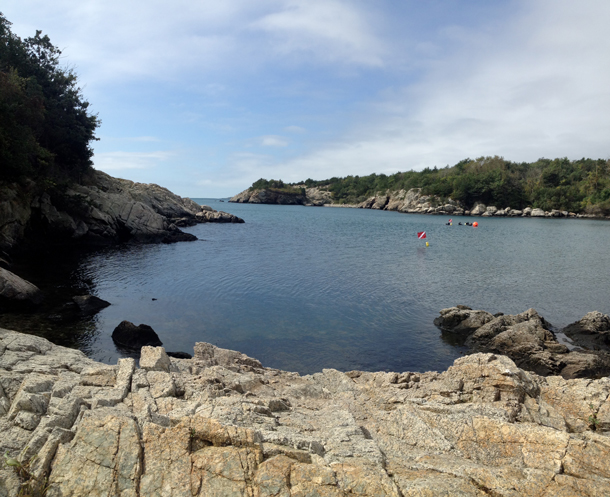
After a cloudy morning at the rescue, the sky cleared, allowing for exceptional water visibility. (Photo: Noble Ingram)
INGRAM: But these are not the fish they’re looking for. Along the shoreline, four divers waddle slowly into the water. Each carries a Tupperware container and what looks like a small butterfly net. The water is clear and the sun is shining but this is no ordinary fishing trip. This is a rescue mission.
DESMARAIS: These fish are going to die because of the water turning cooler as the fall and winter comes. So hey, might as well take the opportunity to rescue them…
INGRAM: That’s Leonor Desmarais. She’s a long-time scuba diving enthusiast and a member of the New England Aquarium Dive Club, a volunteer organization that often partners with the aquarium. As she explains, the group has come to Rhode Island in search of an unusual kind of fish that desperately needs saving.
DESMARAIS: … It is a hunt because you’re hunting for them. You’re just not killing them when you find them deliberately. You’re rescuing them from a certain death to a possible survival.
INGRAM: These threatened sea creatures aren’t native, but they’re not invasive either. They’ve been spotted all throughout New England, and just over 100 miles away, on Nantucket Island, the Mariah Mitchell Aquarium has a small collection of them. On a July afternoon, a staff intern named Jack leads a tour into a room of bubbling fish tanks. Most of the animals here are locals, including the aquarium’s beloved Atlantic lobster, Clementine. But two tanks hold flashier foreigners.

Divers prepare to search for orphans at the 2017 New England Aquarium Dive Club Tropical Fish Rescue. (Photo: Noble Ingram)
DUBINSKY: Our first tropical stray that we have here is our buffalo trunkfish. It was collected two years ago in Madaket Harbor. And what we suspect is these fish spawned somewhere in the Caribbean or somewhere subtropical like off the Carolinas and as juveniles, when they were really weak, they got caught in the Gulf Stream, which is a big current that makes its way up the US eastern seaboard. And there’s a little spigot of it that comes out towards Massachusetts here.
INGRAM: As Jack explains, this tropical fish was found here in New England after riding ocean currents for hundreds of miles. Now three years old, this blue blob is about the size of an apple, with a face that’s strangely reminiscent of an Easter Island stone head. It’s known as a Gulf Stream Orphan.
DUBINSKY: As a little baby, this buffalo trunkfish was the size of a blueberry when we caught it.
INGRAM: As Jack points out, the fish has grown fast. And now, it’s attracting some serious attention from visitors.
MCKAY: He’s got a lot of personality. Hi, you’re very handsome… Hi, I think you’re my friend. I wouldn’t mind finding one of you.
HOIGHT: He kind of looks like a truck of some kind or a weird UFO.
DUBINSKY: He loves eating live shrimp…
MCKAY: So do I…
INGRAM: The buffalo trunkfish is not the only tropical species to be carried into New England. Others include bright yellow Spotfin Butterflyfish and Atlantic Blue Tangs, relatives of the Pacific fish featured in the Finding Nemo and Finding Dory films. After the tour, Jack steps outside onto the beach.
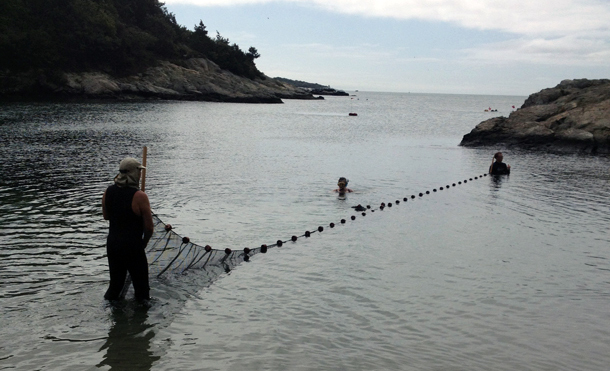
New England Aquarium Dive Club members prepare to haul a seine net through the shallows. (Photo: Noble Ingram)
INGRAM: What’s the best thing you’ve caught?
DUBINSKY: Personally, ever? A flying gurnard was a really rare tropical that we caught five years ago. It’s this beautiful fish with bright iridescent blue wings. Usually only found in the Caribbean. We had it at the aquarium for four years and it got so big we donated it to the New England Aquarium.
INGRAM: As an adult, the Flying Gurnard looks like a glowing purple Frisbee. And biologists at the New England Aquarium were thrilled to receive it. One in particular, Mike O’Neil, manages the Giant Ocean Tank there, and is completing a PhD studying Gulf Stream Orphans.
O’NEIL: So we met the Maria Mitchell Association at the Hyannis ferry and received this flying gurnard from their facility. They had him set up in a nice temperature-controlled cooler— very well-packed.
INGRAM: Raising a captured tropical orphan is no simple task. Five years in, that flying gurnard died from a bad eye infection. But plenty of other orphans at the aquarium have survived and thrived. And for Mike, gazing into the New England aquarium’s vast Caribbean collection, saving these fish from a deadly fate drives his studies.
O’NEIL: We went down for one of the field collecting trips and I could not believe that the fish we were going to be bringing back we would find normally in the Caribbean. And one of the first fish that we found was a permit, when we found it a very small, plain silver fish.
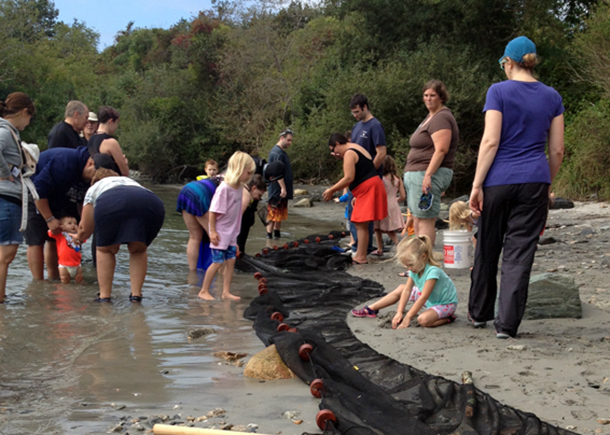
Volunteers of all ages parse through their catch, looking for Gulf Stream Orphans. (Photo: Noble Ingram)
INGRAM: Mike nods at the tank and points to a glistening fish the size of a bicycle.
O’NEIL: But it’s actually one of the two largest fish in our Giant Ocean Tank right here; they get to be maybe a hundred pounds or so and a couple feet long. It was like an out-of-body experience at first being like, “We could raise this up and bring it back to the aquarium and it could live in the giant ocean tank for a decade or more and be this massive animal”.
INGRAM: As Mike explains, even the mighty permit was found as a tiny grey speckle. That might be the biggest challenge to finding orphans: unlike the colorful adults we recognize, juvenile tropical fish look mostly like seafloor pebbles.
O’NEIL: That brown blob is a trunkfish. You can see his little mouth and his two eyes there, when we collect them, they’re teeny tiny. They get to be about football-size when they’re full-grown.
INGRAM: That looks like a rock.
O’NEIL: Yup. That’s one of the ones that when you come across, it’s usually just sheer luck that you happen to be seining in the right spot and then as you’re looking through it instead of looking at pebbles you’re like, “Oh wait this one actually has fins and is alive”.
INGRAM: That luck is critical – and not just for the rescuers. As Leonor mentioned earlier, Gulf Stream Orphans can tolerate New England’s warm summers, but when water temperatures plummet in the fall, fish that can’t stand the cold die. And that brings us back to Jamestown in September. Mike O’Neil is here along with his colleague Mike Whyte. The pressure is on to find these orphans, Whyte says.
WHYTE: They’re going to die. It’s inevitable. They will die probably within the next month. So if we can get it and bring it back and use it in our exhibits it sends a big message out. So it’s very important.
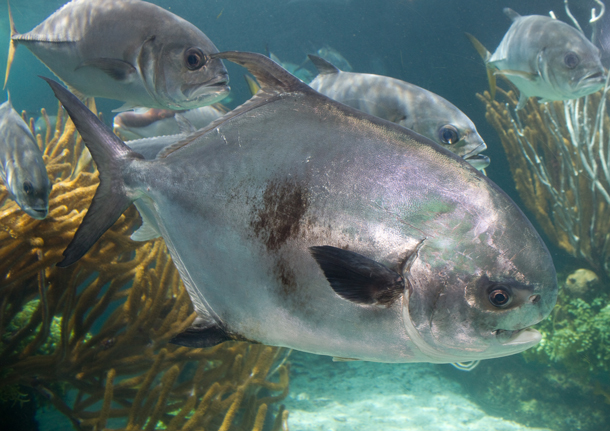
An adult permit swims through a coral reef in its native Caribbean. When fully-grown, these fish can top out at 50 pounds. (Photo: Brian Gratwicke, Flickr CC BY 2.0)
INGRAM: But so far, this year’s haul isn’t looking promising. Three hours in, a few divers have made sightings, but every net is still empty.
BEACH PERSON: One of the divers who’s with the aquarium saw a Spotfin but didn’t have any luck in catching him.
WHYTE: Nothing in the nets yet but we’re going to try the seining and see what we come up with there.
INGRAM: Each time the seine net comes in, Mike and the dive club find a new tangle of fish, but they’re all locals.
O’NEIL: We don’t have anything tropical in this guy.
INGRAM: Then, amid the controlled chaos of another haul, a pair of divers head over to Mike with a gallon-sized plastic tub. Mike points to a brown spot swimming in their catch.
O’NEIL: That little dark guy with a red eye is a permit.
CROWD: Oh my god, little baby permit. You’re kidding me. That dark huh?
O’NEIL: Yup, that’s stress coloration. He’s figuring out why everyone’s looking at him.
INGRAM: Potentially a successfully caught Gulf Stream Orphan?
O’NEIL: Yup, that permit is definitely on the Gulf Stream Orphan list. Definitely at that size that guy is maybe half an inch long, something like that… they’ll grow up to be very, very large.
INGRAM: Mike hands the tub, and its future 50-pound fish, back to the divers. The proud rescuer poses for a photo with the permit. For now, the dive club will have to be content with their single rescued orphan.
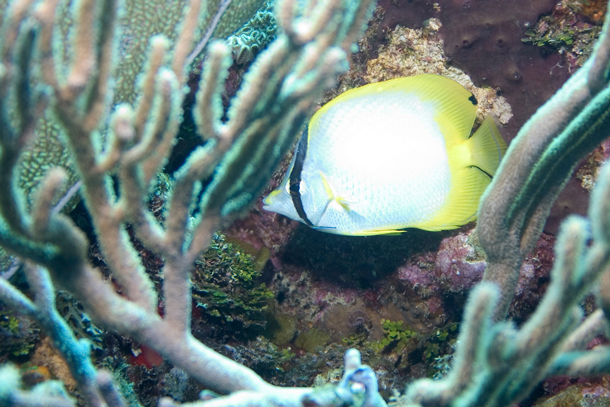
An adult Spotfin Butterflyfish weaves through coral in the wild. Though these fish were spotted at the rescue, none were caught. (Photo: Kyle Johnson, Flickr CC BY-NC-ND 2.0)
O’NEIL: Fish-wise, little bit left to be desired. We did get a few reports of tropical fish and we do have one permit in hand. So from a New England Aquarium perspective, not ideal for the collection animals, but for the Gulf Stream Orphan project, definitely excellent data. Weather turned out great, dive conditions were perfect. Can’t ask for much more.
INGRAM: Day overall still definitely worth it?
O’NEIL: Oh yeah. Absolutely. Particularly to see future marine biologists in training out here, and getting wet and learning about their native environment - it’s the way to go.
INGRAM: Every fall, the New England Aquarium Dive Club’s event gives citizen scientists of all ages the chance to save just a few tropical fish caught in the region’s cooling waters. Thanks to this year’s outing, more people are now enlisted orphan rescuers. And one tiny permit here gets to make it past October. For that, at least, it seems safe to call it: mission accomplished. For Living on Earth, I’m Noble Ingram in Jamestown, Rhode Island.
Related links:
- Gulf Stream Orphans Project
- Gulf Stream Orphans at the New England Aquarium
- Mariah Mitchell Aquarium
- New England Aquarium Dive Club’s Tropical Fish Rescue
[MUSIC: Doc Watson, “Fishing Blues”, on Elementary Doctor Watson!, composer unknown/first released by Henry Thomas, Tomato Music
https://www.youtube.com/watch?v=W22JQDuLgR8]
No Northern Right Whale Calves So Far This Year
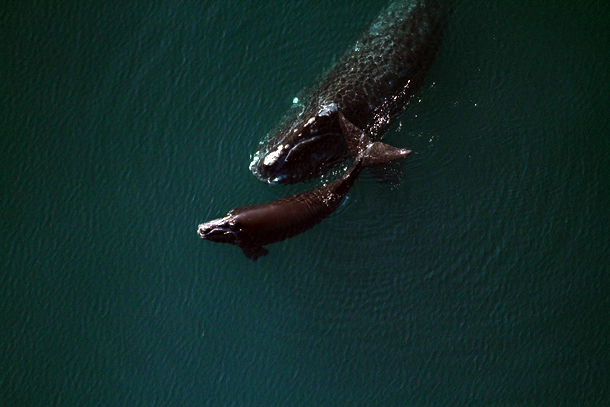
A mother North Atlantic right whale and her calf off the coast of Florida. This year’s apparent lack of any newborn North Atlantic right whale calves could spell disaster for the critically endangered species. (Photo: FWS Fish and Wildlife Research Institute, Flickr CC BY-NC-ND 2.0)
[SOUND OF RIGHT WHALE CALLING]
CURWOOD: Northern Right whales have reason to sound mournful. They’re lonely.
Though it’s been illegal to hunt them since 1935, the numbers of this favorite target of the whaling industry are down to about 450 and moving ever closer to extinction.
The warming ocean has prompted them recently to move north from their usual summer feeding grounds in the Gulf of Maine into Canada’s Gulf of Saint Lawrence. Canada has fewer rules protecting them from ship strikes, and some eighteen of these rare giants died this past season alone. And now comes a report that this already critically endangered population has produced no new calves in the past year. To learn more, Living on Earth’s Jenni Doering spoke with Regina Asmutis-Silvia, of the non-profit Whale and Dolphin Conservation.
DOERING: So Regina Asmutis-Silvia, why do we think that there have been no Right whale births this year off the coast of the US?
ASMUTIS-SILVIA: So, Right whales are an intensely studied species because they are so critically endangered, there are a number of dedicated surveys that happen in what has been their dedicated calving area. And there haven't been...there have been very few whales who have shown up there, none with calves, and there's also intensive surveys that are happening in Cape Cod Bay which is another winter, early spring habitat for them, and there's been no calves sighted in that area as well.
DOERING: How unusual is this?
ASMUTIS-SILVIA: It's unprecedented. We've never ever ever had a year we didn't have a single calf born to the population.
DOERING: And how many whales are in the population as a whole?
ASMUTIS-SILVIA: Probably between 430 and 450 at best.
DOERING: But I understand, like not a lot of those are females, right?
ASMUTIS-SILVIA: No, so unfortunately because of human impacts the population impacts have been more harmful to females at this point, so there's probably only about 100 breeding females left.
DOERING: Why is that? Why are the females suffering more?
ASMUTIS-SILVIA: We always do? [LAUGHS] It's a good question. I mean, I think that they tend to be more coastal, oftentimes they tend to spend a lot more time at the surface particularly if they're having calves. So, they're in areas where if they get pregnant, they need to feed more. So, I think that they're more susceptible to a lot of human impacts just because of their life history, what they need to go through, so that they just tend to be in more risky areas.
.jpg)
The North Atlantic right whale faces threats from entanglement in fishing gear and vessel strikes. Climate change is also causing the species’ food to shift farther north where there are fewer protections for these endangered cetaceans. (Photo: Moira Brown and New England Aquarium, Wikimedia commons, public domain)
DOERING: So, if you tell me a bit more about like why would they not be having any new calves this year. What could be affecting that?
ASMUTIS-SILVIA: I think it's a combination of things. It's not one particular issue, but the biggest issues that they're facing right now are fishing gear entanglements and vessel strikes, but we know that even if they can survive a fishing gear entanglement that there is what is referred to as a sub-lethal effect, and so the stress that entanglement put them under then causes a lot of stress to their body, increase in stress hormones that makes it a little bit harder for them to get pregnant or to carry a pregnancy to full term. That's one issue.
The other thing is that they may not just be getting fat enough as climate is changing and their food resources are moving around and they're looking for maybe alternative food. It might not be as healthy for them, it might not be make them as fat as they should be, and so females have to eat to get really really fat to be able to produce those hormones that allow them to ovulate, so it's probably a combination of those things.
DOERING: So, let's talk a little bit about why – why is this important. Why does this matter on a larger scale, and what role do Right whales play in the environment?
ASMUTIS-SILVIA: My favorite thing to talk about is that whales are an incredibly important part of our ecosystem and there is emerging research that’s coming out in confirming that they play this incredibly important role as the ocean gardener. So, we need phytoplankton, the planet, humans, we need phytoplankton and that produces half of our oxygen, it is the base of the marine food web, it sustains fish stocks, it takes in carbon dioxide when it photosynthesizes, and so it sequesters carbon, it fights climate change. So, we need phytoplankton and what phytoplankton need are whales because they can't root into the soil, so they can't get their nutrients the way that a plant on land would, so you need the nutrients brought to them and that's where whales come in.
So whales are great at diving and they can do lots of things deep, but what they can't do when they're at depth is they can't poop. So, bathroom breaks are all at the surface and, it's the bathroom breaks that are fertilizing phytoplankton at the surface. So, that's where they get phosphorous and iron and all the things that they need, so they literally are tending this forest in the ocean that we need to survive. So, if we need phytoplankton and phytoplankton need whales, then we need whales and Right whales along with a lot of other whale species play that really integral role.
DOERING: And they're not eating the phytoplankton directly right? What are they feeding on?
ASMUTIS-SILVIA: So, for North Atlantic Right whales, they're feeding on a different kind of plankton, zooplankton. It's a tiny little animal called the copepod, and so the copepods are grazing on the phytoplankton. So, they're eating these tiny little animals which also kind of free float around at the surface and they require ocean currents to kind of concentrate them to a point where the Right whales can feed on them, so Right whales are very dependent on a healthy climate and a healthy planet to be able to do their job because they need these physical parameters to concentrate their food for them.
DOERING: You talked about how entanglements in fishing gear is really hurting these whales and making it more difficult for them to get pregnant. What kind of gear is that and why does that happen? Why do they get tangled up?
ASMUTIS-SILVIA: So, primarily what they're getting entangled in is the kind of gear that we refer to as a fixed fishing gear, and it's gear that set out there and left to fish and then retrieved at another point - lobster, crab, gillnetting, hagfish - those are I think the things that people are more familiar with in this area where all those pretty colorful marker buoys that you see at the surface off the coast are marking some vertical line that's at the bottom attached to a trap, and certainly the snow crab fishery in Canada is where there were a lot of entanglements last year. And I think it's incredibly important to clarify that this is not intentional. Fishing gear has been changing and evolving and so that ropes that used to be made of hemp or natural fibers which might have deteriorated a little bit more quickly are now being made out of plastic polymers and so that they're more sturdy for the fisherman, but that means that they're stronger and they're more sturdy when the whale gets entangled into them too, and there's no evolutionary adaptation that says that they should be worried about this.
So, they're in places, they're doing what they're supposed to do, they're socializing, they're feeding, they're chatting, they're doing whatever, and they will bump into gear. What they seem to do though is that they roll into it. It's kind of like they choose the path of least resistance, so if it doesn't - and I'm speculating here - but if it if it doesn't feel good when you're pulling against it then roll, and maybe you're not pulling against anymore but now you've become even more entangled in it. So, they do tend to roll into the gear. That exacerbates the entanglement. It's really really strong, long-lasting like I said, plastic kind of lines that they're getting in tangle in that aren't going to deteriorate in any way, shape or form and so now six months later they've got a piece of gear that's literally either acted as a tourniquet and cut off a blood supply, sawed into tissue or bone, resulting infections will kill them, and it's a really horrible way to die.
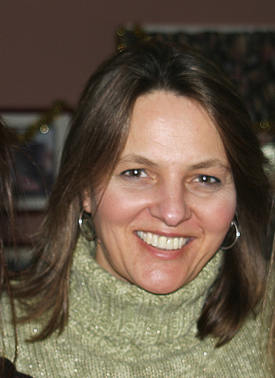
Regina Asmutis-Silvia is the Executive Director and Senior Biologist of the North American branch of the non-profit, Whale and Dolphin Conservation. (Photo: Courtesy of Regina Asmutis-Silvia)
DOERING: In the past year, Regina, 18 North Atlantic Right whales were found dead, 12 of which were found as far north as the Gulf of St Lawrence and Canada. And how is the lack of right whale births this year connected to this unprecedented death rate that we saw this past year?
ASMUTIS-SILVIA: It's devastating. If you want to recover an endangered population, you need to recruit more than you kill. So, if you had 18 die then you need more than 18 born to even try and just mildly offset that, so to have 18 dead and then no calves born is really definitely adding another nail to the coffin.
DOERING: So, you mentioned climate change is causing their food source, copepods, to move around. How much understanding do we have of that movement and what do you think the whales know?
ASMUTIS-SILVIA: Whales know a whole lot more than we do. I mean, certainly their distribution changing is telling us that they know a whole lot more than we do. So, if they're not finding what they want where they used to get it, they're going someplace else to look for it. We have no idea how they find their food, not a clue. So, we don't know if it's an acoustic detection, we don't know theoretically...they don't have this great olfactory functioning, but I don't know that we really understand all that that well either. So, whatever senses that they're using to find food, they're way better at that than we are.
The studies that have been done by the Center for Coastal Studies in Cape Cod Bay show that they won't even open their mouths if that concentration of copepods isn't enough. How they figure that out, we don't know, but they - the copepods that they feed on are typically what they're feeding on in the Gulf of Maine are very temperature dependent, and so if there are having issues with the Gulf of Maine warming faster than the rest of the North Atlantic, those concentrations of that particular kind of copepod seem to be diminishing. There's researchers at Dalhousie University that are looking at the copepods that they're feeding on in the Gulf of St Lawrence and it's a different species, it's an Arctic species and somehow they've figured out that it's there, and that that's an alternative food source for them.
DOERING: Do you see hope for next year? You know, do you see this population recovering?
ASMUTIS-SILVIA: I always see hope. I can't fathom that we would allow them to go extinct. I mean, we did this, we can undo it. So, I think we just have to figure out and be creative and be thoughtful, and everybody has to kind of pull together to do it. And then there is a lot of work being done with Woods Hole right now trying to look at how to develop gear that doesn't have that vertical line in the water.
There is the National Marine Fishery Service is holding some subgroups that are trying to look it either implementing ropeless gear or a weaker line gear. We've already done sort of a good job a little bit I think in the US with reducing ship strikes. We need to do that in Canada. And I think that there's hope and I also think that’re not our whales, they belong to everybody, we all need them. So, that means that everybody has a say in this, and everybody has something they can do, and so if we know that a change in climate is a problem then everybody collectively can do something to help with that too. So, those sort of old adages about recycling and reusing, they add up, and they are meaningful. So we all have a stake in this.
CURWOOD: Regina Asmutis-Silvia is senior biologist with Whale and Dolphin Conservation. She spoke with Living on Earth’s Jenni Doering.
Related links:
- The Boston Globe: “After year of record deaths, right whales produce no new calves, which could be ‘catastrophic’”
- Whale and Dolphin Conservation homepage
- NOAA, “Sounds in the Ocean”
[MUSIC: Loreena McKennitt, ”The Parting Glass” on The Wind That Shakes the Barley, Traditional/arr.Loreena McKennit, Quinlan Road/Verve Records/ Universal Music ]
CURWOOD: Coming up, Catching up with humpback whales in their Caribbean love nest. That’s just ahead here on Living on Earth, stay tuned.
ANNOUNCER: Funding for Living on Earth comes from you our listeners, and United Technologies - combining passion for science with engineering to create solutions designed for sustainability in aerospace, building industries and food refrigeration. UTC companies such as Otis, Carrier, Pratt & Whitney and UTC Aerospace Systems are helping to move the world forward. You can learn more about United Technologies by tuning in to the Race to 9 Billion podcast, hosted by UTC’s Chief Sustainability Officer. Listen at raceto9billion.com. That’s raceto9billion.com. This is PRI, Public Radio International.
[MUSIC: Loreena McKennitt, ”The Parting Glass” on The Wind That Shakes the Barley, Traditional/arr.Loreena McKennit, Quinlan Road/Verve Records/ Universal Music]
Ocean Health: Some Hope and Much Peril

Menhaden are a key species in the marine food chain, bridging plankton and large predators. In recent years large schools of menhaden have made a comeback in the coastal Atlantic Ocean off North America. (Photo: Brian.gratwicke, Wikimedia Commons CC BY 2.5)
CURWOOD: It’s Living on Earth, I’m Steve Curwood. Tens of thousands of dead starfish, crabs, and other sea creatures recently washed up on beaches in the UK.
Scientists are blaming the deaths on a severe cold snap that brought freezing temperatures and snow to much of Europe. Wildly fluctuating weather is consistent with what scientists expect from a changing climate. MacArthur ‘genius’ and noted ecologist Carl Safina says we shouldn’t be surprised.
SAFINA: In the 90s, we used to hear that global warming was coming. Now, every place I go there is something going on that has to do with the fact that the climate is warmer than it used to be.
CURWOOD: Indeed. So, how exactly is the warming, is the climate disruption affecting the oceans and the plants and animals that live there?
SAFINA: Well, and in a variety of different ways. I mean, it depends a little bit on what system in the ocean you're talking about. Things in the tropics are having a harder time as water warms up and things in the temperate latitudes are moving toward the poles. So, you see some things that can move quickly, like fish, spending more of their year farther north than they used to, things that cannot move very much like the lobsters in Long Island Sound where I live, you know, they're sort of trapped in Long Island Sound, and if you move north you wind up on the Connecticut Turnpike. So, the lobsters over the last 15 years have basically died, almost all the lobsters in Long Island Sound have died. And a friend of mine who used to make a living catching them there, he is now a nurse.
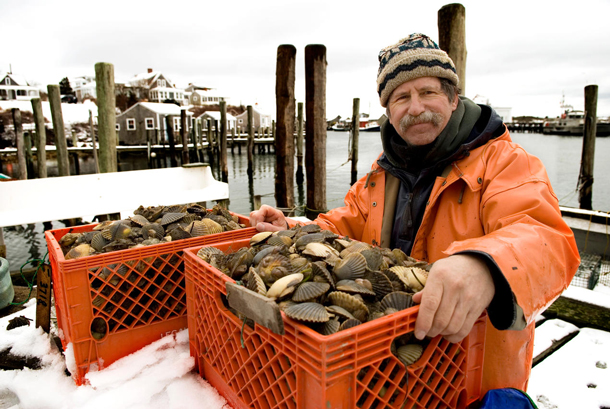
Ocean acidification, and the resulting thinner shells on shellfish, are particularly worrying to shell fishermen. (Photo: Massachusetts Office of Travel and Tourism)
CURWOOD: Talk to me about ocean acidification. How is this related to the warming and what exactly is happening to the oceans?
SAFINA: All of our combustion, all the engines that we run, all the forest and farms that we are burning, that sends carbon dioxide up into the air and a lot of it reaches the face of the ocean, the surface of the ocean. At that interface a lot of it dissolves into the water. When it dissolves in the water, it creates a short chemical reaction that releases hydrogen atoms, and those hydrogen ions in the water are measured in a way that we call Ph, h for hydrogen, and the more of them there are, the more we consider it to be more acidic, or more toward the acid end of the Ph scale, and everything that makes a shell in the ocean, their shells are getting thinner and weaker, or the larval forms can't even make their first shells, and they quickly die and dissolve or become fatally deformed, and it's not a few small little obscure things. It's things like all of our shellfish and all of the coral reefs of the world and much of the plankton. That's really an enormous, enormous effect and an enormous change.
CURWOOD: So, a lot of humanity enjoys eating fish. How are fish stocks doing around the world right now?
SAFINA: Well, it's interesting. If you had asked me this around 20 years ago which I think you did ask me this around 20 years ago,
CURWOOD: Indeed!
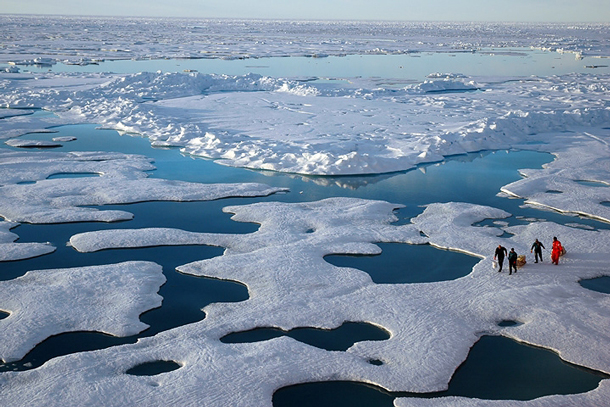
Melting ice in the Arctic has the potential to disrupt the Gulf Stream, which keeps Europe warmer that it would be otherwise. (Photo: Jeremy Potter / NOAA)
SAFINA: I would have said that basically all of the fish populations in the world are being rapidly depleted, and that was true at the time. Since then, because of a lot of effort that we expended in the United States to improve the federal laws that govern fishing, we have recovering trends in many of the important ocean fish that are fished commercially and that people like to eat. Some of the in shore fish, like some of the flounders that we have in our region - we have summer flounder that's been doing a lot better, we have black sea bass that's kind of exploding in population size and number.
Another thing that was pretty interesting was that there's a fish that people do not eat called Menhaden - it's related to Herring but people don't eat it - it's got an incredibly high oil content which means also it's got a lot of calories and people usually catch them in gigantic quantities and create fish meal and animal meal out of them that are fed to livestock or used in fish farms and they were heavily depleted. But five years ago a cap was put on them and they couldn't catch as many and they started recovering noticeably almost immediately, and because they are such high calorie fish, everything that eats fish was moving into the coastal waters.
We would be out fishing in my boat just a mile or two from shore and there be whales around the boat. There were schools of sharks in the surf, behavior that people never thought these kind of sharks would do and they were just chasing these fish all over the place. It became an ocean that I had never seen before. It was not the ocean of my youth or my whole previous lifetime and it made me wonder what else the coast must have looked like that we don't even imagine in the incredible abundance that was here that most of which we've lost. But this was a tremendous recovery trend.
CURWOOD: In the coral reefs I understand there's some new research that looks at how plastic is getting all entangled in those corals and causing a lot of problems. What's going on with that?
SAFINA: It's not uncommon to see plastic tangled around coral. Of course, as there is wave action or currents, it helps to break the coral up. Anything that attaches to coral usually grows bacteria or does something that is bad for coral while it's stuck on them. It can shade them out, the bacteria can grow on that item and then jump over to the coral. It can create surfaces that baby coral cannot attach to and get growing in life or they may attach to the wrong thing where they - they simply can't survive. That part is not just the problem with plastic. It's even a problem with seaweed. On a lot of coral reefs where there's been too much fishing, the fish that eat seaweed are so depleted that the reef gets overgrown with seaweed and then the fronds of the seaweed grow bacteria that can infect the corals.
CURWOOD: So, the Trump administration recently announced their intention to allow offshore oil and gas drilling for nearly all US coastal waters. Carl, I believe you wrote an entire book about the Deepwater Horizon Oil blowout. What did you call it? A sea in flames?
SAFINA: Yes.
CURWOOD: So, talk to me about how more oil drilling affect the ocean in coastal areas of the US.
SAFINA: Yes, you know, most people think that oil exploration and drilling is bad because you get these occasional catastrophic spills like the Exxon Valdez and you get these blowouts like the Deepwater Horizon, but the real catastrophe is the oil that we just take every day, the daily grind of extraction and everything that goes with it. You have to build big ports, everything gets dirty, you have to build big refineries, you have to build highways, and it's this daily grind that really creates over time more damage than the catastrophic spills as damaging as they are.
Then, when you're exploring you have to make a tremendous amount of noise, noise that many marine mammals and whales cannot take. It can sometimes deafen them or cause them to panic from the deep and get the bends as they come to the surface too quickly, meaning that they can die or their eardrums can rupture. They may not be able to hear their own sonar, so they won't be able to figure out where the food is that they're trying to hunt. There's a lot of stuff about this whole business that is nasty.
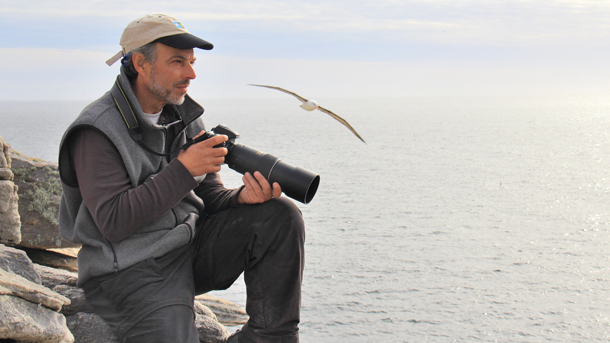
Carl Safina (Photo: Pat Paladines)
CURWOOD: You talked about the rising fish stocks as a positive sign. Come the end of the day, what gives you hope these days, Carl Safina?
SAFINA: Well, I have a definition of hope, and hope to me is the ability to see how things could be a lot better. Plastic is a problem. OK, well, we know that there are other materials being developed. Energy is a problem...we know that there are clean energy technologies that are starting to really take hold in some other countries of the world. We see that when people do the right things and work toward the right things that the problems either get better or they get solved, and that's what gives me hope.
CURWOOD: Prize-winning ecologist Carl Safina is the author of several books about the ocean and animals. Carl thanks so much for taking time with us today.
SAFINA: Always a great pleasure Steve.
Related links:
- Carl Safina
- National Oceanic and Atmospheric Administration
[MUSIC: Mike Marshall and Darol Anger, “Dolphins” on The First Ten Years, Disc 2, Windham Hill (originally released on Chiaroscuro by Windham Hill)
https://video.search.yahoo.com/search/video?fr=mcafee&p=darol+anger+dolphins#id=1&vid=5ea772c65395700ef0ae9249ff5dd13e&action=click ]
Whales at Home in the Caribbean

Humpback whale (photo: bigstockphoto.com)
CURWOOD: Earlier in the show we mentioned there have been no Northern Right whale calves seen off the Atlantic coast so far this year – but other whales in the region, including humpbacks are doing much better.
[HUMPBACK WHALES SINGING]
CURWOOD: Known for their alluring songs, Atlantic Humpbacks spend their summers in nutrient rich cold northern waters where they fatten up on krill and small fish, and then head south for the winter to cozy up, mate and give birth.
A while back, Living on Earth’s Bobby Bascomb found the humpbacks delighting tourists just offshore in the Dominican Republic.
[BOAT RIDING ON WAVES]
BASCOMB: Some 50 visitors from around the world lean over the rail of the whale watching boat Porto Mia. They scan the clear blue waters of the Caribbean Sea, searching for humpback whales.
[CROWD CHEERING]
FABIAN: Oh, there he is right there! Right there, he’s up! Do you see the whale? Maybe it’s a she actually, who knows? Oh right there!

Humpback breaching (photo: bigstockphoto.com)
BASCOMB: There are three separate populations of humpbacks worldwide. One group lives in the Southern Hemisphere, another in the Pacific Ocean, and a third in the Atlantic Ocean. And the three populations never meet. The north Atlantic group feeds in the Gulf of Maine, or off the coast of Greenland and Norway but almost all of them come here, to the Dominican Republic, to mate or give birth.
BEDDALL: That makes them Dominican citizens. They’re born here, they hold Dominican passports. They go north to feed. They always come back to the country where they were born.
BASCOMB: Kim Beddall is a marine mammal specialist. She’s been studying humpback whales for 30 years here in the Dominican Republic.
BEDDALL: They do not eat here for 5 to 6 months every year, so they’re living on a stored layer of body fat that they’ve accumulated in their northern feeding grounds. Baby humpback whales are drinking 200 liters of milk every day and growing at 100 pounds daily. And a mother is producing all that milk and she’s not feeding herself. So a female humpback whale will lose about 25 percent of her total body weight the winter she gives birth.
BASCOMB: No one knows for sure why the North Atlantic humpbacks choose the Dominican Republic for their nursery, but Beddall has a theory
BEDDALL: This is probably the closest most appropriate place where the entire population can mix. The mother might be a whale that feeds in the Gulf of Maine and the father might be a whale that feeds in Norway and that guarantees a genetic difference in order to produce healthy offspring.
[WHALE CALLS]
BASCOMB: A hydrophone the crew dropped into the water records the sounds of a lone male humpback trying to sweet-talk a female.
[CROWD ON BOAT]
BASCOMB: There are actually more humpbacks in Dominican waters now than just a few decades ago. Since 1966 the population has risen from roughly 1,000 individuals to 16,000. North Atlantic humpbacks are no longer considered endangered, but Kim Beddall says that doesn’t mean they are safe.
BEDDALL: Humpback whales are coastal animals. This brings them into contact with human activity. So if you combine aboriginal whaling with entanglements in fishing gear, ship strikes, global warming, contamination of their feeding areas and reproductive areas, there’s a lot of threats to humpback whales in all the world’s oceans.
[PLAINTIVE WHALE CALLS]
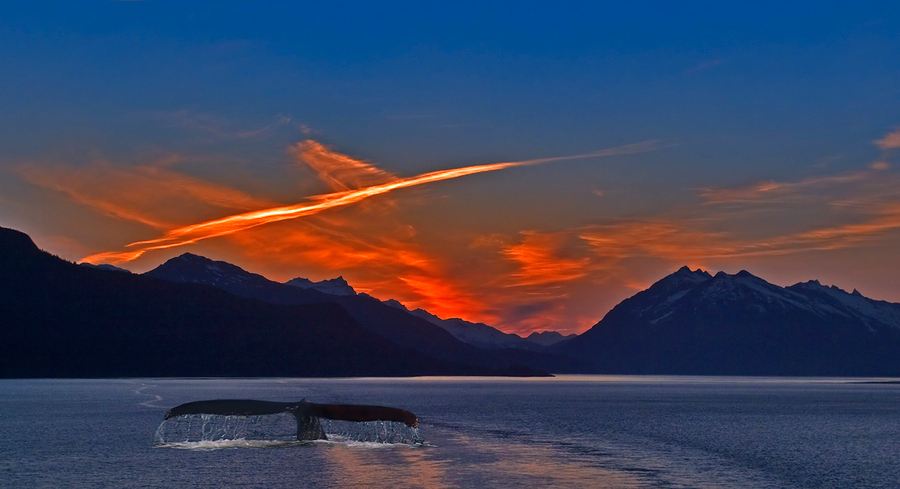
A humpback at sunset (photo: bigstockphoto.com)
BASCOMB: Of all the humpbacks in the world’s oceans, the Dominican group is arguably the best protected.
BEDDALL: Our National Marine Mammal Sanctuary here in the Dominican Republic is sister sanctuary to Stellwagen Bank National Marine Sanctuary off the coast of Boston. So, we’re protecting them here in their reproductive area and then off the coast of Boston in one of their feeding areas.
BASCOMB: And that’s where all those whales are heading now, to feast on krill in the cold, food rich waters of the North Atlantic.
For Living on Earth, I’m Bobby Bascomb in Samana, Dominican Republic.
Related link:
Whale Samana website
[MUSIC: Electric Light Orchestra “The Whale” from Out Of The Blue (Epic Records
1977)]
CURWOOD: Your comments on our program are always welcome. Call our listener line anytime at 617-287-4121. Our e-mail address is comments at loe dot org. And visit our web page at loe dot org. That's loe dot org.
[MUSIC: Charles Mingus, “Jelly Roll” on Ah Um!, Not Now Music]
CURWOOD: On the next Living on Earth, Paleontologists have found a new cache of fossils in the Bears Ears region.
GAY: The site is enormous. It’s the largest Triassic bone bed in the state of Utah. The amount of fossils that we’re finding in there means it’s one of the densest probably in the country, if not the entire world.
CURWOOD: But with the monument shrunk, the find is more vulnerable to looters. That's next time on Living on Earth.
[MUSIC: Charles Mingus, “Jelly Roll” on Ah Um!, Not Now Music]
CURWOOD: Our crew includes Naomi Arenberg, Bobby Bascomb, Savannah Christiansen, Jenni Doering, Noble Ingram, Jaime Kaiser, Hannah Loss, Don Lyman, Helen Palmer, Aynsley O’Neill, Adelaide Chen, and Jolanda Omari.
Tom Tiger engineered our show, with help from Jake Rego. Alison Lirish Dean composed our themes. You can hear us anytime at L-O-E dot org - and like us, please, on our Facebook page - PRI’s Living on Earth. And we tweet from @livingonearth. I’m Steve Curwood. Thanks for listening!
ANNOUNCER1: Funding for Living on Earth comes from you, our listeners, and from the University of Massachusetts, Boston, in association with its School for the Environment, developing the next generation of environmental leaders. And from the Grantham Foundation for the protection of the environment, supporting strategic communications and collaboration in solving the world’s most pressing environmental problems. Support also comes from the Energy Foundation, serving the public interest by helping to build a strong, clean, energy economy, from Carl and Judy Ferenbach of Boston, Massachusetts and from SolarCity, America’s solar power provider. SolarCity is dedicated to revolutionizing the way energy is delivered by giving customers a renewable alternative to fossil fuels. Information at 888-997-1703. That’s 888-997-1703.
ANNOUNCER 2: This is PRI, Public Radio International.
Living on Earth wants to hear from you!
Living on Earth
62 Calef Highway, Suite 212
Lee, NH 03861
Telephone: 617-287-4121
E-mail: comments@loe.org
Newsletter [Click here]
Donate to Living on Earth!
Living on Earth is an independent media program and relies entirely on contributions from listeners and institutions supporting public service. Please donate now to preserve an independent environmental voice.
NewsletterLiving on Earth offers a weekly delivery of the show's rundown to your mailbox. Sign up for our newsletter today!
 Sailors For The Sea: Be the change you want to sea.
Sailors For The Sea: Be the change you want to sea.
 The Grantham Foundation for the Protection of the Environment: Committed to protecting and improving the health of the global environment.
The Grantham Foundation for the Protection of the Environment: Committed to protecting and improving the health of the global environment.
 Contribute to Living on Earth and receive, as our gift to you, an archival print of one of Mark Seth Lender's extraordinary wildlife photographs. Follow the link to see Mark's current collection of photographs.
Contribute to Living on Earth and receive, as our gift to you, an archival print of one of Mark Seth Lender's extraordinary wildlife photographs. Follow the link to see Mark's current collection of photographs.
 Buy a signed copy of Mark Seth Lender's book Smeagull the Seagull & support Living on Earth
Buy a signed copy of Mark Seth Lender's book Smeagull the Seagull & support Living on Earth

